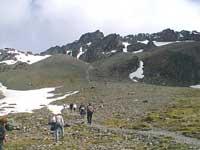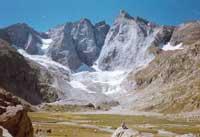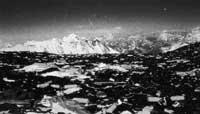Everest, the highest landfill in the world
2004/06/14 Atxotegi Alegria, Uhaina - Elhuyar Zientziaren Komunikazioa
The latest tourism surveys have shown that we are increasingly travelers. The ‘trip’ is an attractive and pleasant product for travelers, but dangerous for the areas they visit. In fact, travelers are not always clean and, in many cases, they know how to transform the new areas they visit into landfills.
Lover or destroyer of nature?
Many mountaineers hear that the world's largest mountains have become huge landfills. In 1991 the association "Mountain Wilderness" organized a large cleaning expedition to the K2, the second highest mountain in the world, 8611 meters. This type of expeditions have been increasing, especially in well-known valleys such as Everest, Annapurna and Baltoro (Pakistan).
These cleaning groups collect an average of between 2 and 3 tons of garbage. In each of these mountains approximately 100 tons of garbage are collected annually. Sherpes also wanted to participate in these cleaning campaigns. Everest is one of the Himalayan mountains with more garbage; on the one hand, being the highest in the world attracts you and every year thousands of expeditions go there. On the other hand, you need a lot of material to upload it and, as it is expensive to bring it all around, it stops once used.
In these large mountains we can find various garbage, but above all, ropes, oxygen bottles, tents, food packages, cardboard boxes, canned containers and batteries are collected. Despite not believing, Australian cleaners have just collected 56,000 bottles of beer on Mount Everest.
Damage by tourist waves
In the valleys of Everest and Annapurna there are more tourists than inhabitants. For example, in times of greatest influx of tourists there may be four travelers per inhabitant. This massification of tourists has consequences in this exotic territory.
If we look at European alpine tourism, we will see that gradually they have been controlled and limited with specific laws. In addition, quality control services and environmental protection measures (waste, wastewater treatment) have been widely controlled. On the other hand, in the mountains of Nepal tourism development has been totally anarchic and uncontrolled. In addition to its transformation into a landfill, the landscapes have been greatly suffocated; the high number of travelers has considerably increased the consumption of wood, which is causing the emptying of several forests; the value of the houses is increasing; its inhabitants move away from these valleys and the great influx of tourists has caused a deterioration of traditional values.
Measures to combat polluting mountaineers
The Government of Nepal has taken action in the face of this grave situation. It has banned the use of oxygen bottles throughout the region: currently only metal cans that are recycled by the valley neighbors are allowed.
In addition, each expedition must pay between 2,000 and 4,000 dollars depending on the increase. Back on the mountain, if all their waste comes down from the camps, the whole money is returned to them. If not, the government gets that money. On the contrary, waste recycling is the responsibility of its inhabitants.
In these cleaning campaigns, shoerps have also wanted to participate. To do this, in the Everest base camp (5,290 m) they have occurred to open a cybercafé. In this way, climbers should not use expensive satellite telephone systems. This unique bar is powered by solar panels and Internet connections are made by two-way satellite links. The winners of this café will go to clean Mount Everest.
However, unfortunately, cleaning and prevention campaigns are carried out only in the most prestigious summits and mountains in the world. Others are not lucky! It is true that there are mountains that have unfavorable access and that need more human and technical resources than Everest to carry out the cleaning work. It would take highly motivated teams and good financial help to clean these beautiful summits.
Economy or ecology?
What is clear is that if foreigners disrupt the Himalayan port, the government would quickly ban all expeditions. But the organizers of the expeditions take into account especially the purses of the mountaineers, not their ecological consciousness and/or their physical capacity.
It has been half a century since its first climb to the Everest summit, and eleven have had the opportunity to get to know the top or the mountain. Each year 50,000 people approach the Everest and half a million mountaineers to the Himalayas.
Nepal's main source of income is tourism. It earns 160 million dollars a year and works in this sector 200,000 inhabitants. Although these numbers are high, 40% of Nepal's 23 million people live in poverty. They share the economic benefits of tourism between the royal family and the upper class of the Hindu kingdom.
This benefit-sharing has provoked numerous Maoist revolts and 7,000 people have been killed in hostilities since 1996. It has been repeatedly requested that the $70,000 in total Everest hikes be spent on building schools, bridges and clinics in rural areas. However, keep in mind that tourism only causes damage.
Several programs have been implemented in some municipalities to address this situation. For example, thanks to the program Amatoli, Ghandru de Annapurna and the women of the villages of Chomrong organize parties and cultural activities, especially for foreigners. The funds raised are allocated to the cleaning of the villages or to the literacy of its inhabitants. Unfortunately, the money raised in such initiatives is very scarce to meet all your needs and expenses.
It is clear that Nepal lives thanks to tourism. These precious lands that nature has offered them in exchange for kisses have become a source of income. However, like other tourist areas, they have made a strong commitment to the damage caused by visitors. Not controlling tourism and dazzling with money can be dangerous.
We have the ability to step from one moment to another the areas that are admirable to us, but it costs us a lot to be admirable again and not everything is about us. Will nature not be bored by the attacks of tourists?
Dirty tourists, not only on the mountain...Polluting tourism is not only the thing of visitors to the mountains, but also the same with the jump to the coast. Many hikers come, for example, to small islands in Brittany (France). It is noteworthy the case of the Ponante islands, in which agriculture and fishing are completely disappearing in recent years due to tourism. Tourism has greatly transformed the real estate market and expensive homes have been built in every corner. Waste disposal and scarcity of drinking water have become a serious problem. The villages of these islands, for their part, have had to restructure their public facilities (electric transformers, roads and roads...) so that tourists feel comfortable, but all this affects the environment. Today, travelers are fond of travelling anywhere in the world. A clear example of this is Antarctica, where more than 15,000 visitors pass each year. However, these visitors do not abandon them as when they arrived. Apparently, tourists who come to the place, in addition to carrying cameras and video, also carry bacteria in their shoe soles. Tourist footwear, therefore, is putting our ecosystem in serious danger. To prevent this ecological disaster from producing more disastrous effects, Freemantle's doctor Chris Curry (Australia) and his team force tourists to use an effective disinfectant. Any visitor who comes to Antarctica should buy this product. But how can you control if all tourists have clean shoes? For the moment, to avoid infectious diseases or laughter, scientists have asked those responsible for travel agencies to control the shoes of all their customers. |
Institutional resources for the management of protected spaces in Nepal
Government: Department of Nature Conservation Non-governmental organization (NGO): King Mahendra Trust for Nature Conservation (KMTNC) Conservation Government and international NGOs: Department of Tourism, Civil Aviation and KMTNC Mustang Government and international NGOs: Department of National Parks and National Park The Mountain Institute Makalu-Balun Government and international NGOs: Department of National Parks and World Wildlife Fund (USA) |
Published in D2 section of Deia.

Gai honi buruzko eduki gehiago
Elhuyarrek garatutako teknologia





